Upper Wind River

Copyright © 2000-2007, Oregon Kayaking.
No part of this page may be reproduced, linked, or copied without the
express written
permission of the Oregon Kayaking webmaster.
The Upper Wind is an excellent run, one of the Columbia
Gorge's crown jewels. This section is not as hard or as action-packed as
some of the better-known gorge runs, but it still packs a punch,
especially at high water.
This section is the first step many aspiring paddlers take when
moving towards
the harder runs in the gorge. The Upper Wind isn't as intimidating for
first-timers as the Farmlands, so the usual progression is: The Upper
Wind, then the Farmlands, then the
Green Truss and/or
Upper Trout Creek,
and finally, the grand-daddy of all Gorge runs and one of the best steep creeks in the world:
The Little White Salmon.
We usually do this section a couple of times a year; we know it so well that we bomb down it, boat-scouting everything and completing the run
in an hour or so. Some boaters don't like this section because of the long
class II runout at the end, but I see that as a good opportunity
to tune
up my strokes and do a little down-river slalom practice. In addition,
lower part of the
river flows
through a very nice canyon with little sign of human habitation, so the
paddle out isn't really that unpleasant even if you just drift along.
Pete and Tim warm up at the Stabler put-in.
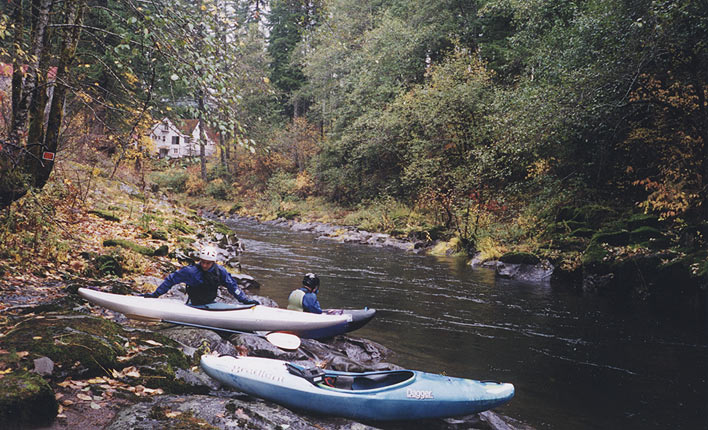
Below the put-in at Stabler Bridge are a few nice play spots and a couple
of warm-up class II-III drops. If you are not a solid class IV boater be
sure you practice a few rolls in this section, because when the rapids
start you'll want to be ready! (It should be noted that the canyon walls
tower overhead on this run; hiking out would be an epic undertaking, but
portaging is always an option if you get in over your head. Therefore,
continuing
downstream is probably better than trying to get up to the road if you
start to get sketched out).
A half mile below the put-in the river
takes a long, gradual right hand turn and drops
out of sight into some large boulders, signaling the start of Initiation.
Below Initiation the rapids don't really stop for two miles- it is
basically one big boulder garden with lots of technical paddling and a few
pools to catch your breath in.
Jonathan Fowlkes working his way down through the bottom of
Initiation. About half of the rapid is visible in this picture.
 The next big horizon line is Ram's Horn. This drop is pretty easy if you
run it far left, or you can go down the middle through the big hole with
momentum. I've never seen anyone get munched here, but I'm sure it happens
from time to time. (You can scout or portage Rams Horn on either side,
and if you want to have some bonus fun it is possible to do laps
by taking out on the right and scrambling upstream over some boulders.) In
recent years a fisherman's access has been added here, so expect to see
hordes of fishermen here during the salmon runs.
Ryan Scott charges into Rams Horn on a recent winter run while the snow falls hard.
The next big horizon line is Ram's Horn. This drop is pretty easy if you
run it far left, or you can go down the middle through the big hole with
momentum. I've never seen anyone get munched here, but I'm sure it happens
from time to time. (You can scout or portage Rams Horn on either side,
and if you want to have some bonus fun it is possible to do laps
by taking out on the right and scrambling upstream over some boulders.) In
recent years a fisherman's access has been added here, so expect to see
hordes of fishermen here during the salmon runs.
Ryan Scott charges into Rams Horn on a recent winter run while the snow falls hard.
The bottom hole is visible downstream, and it gets bigger the farther right you go.
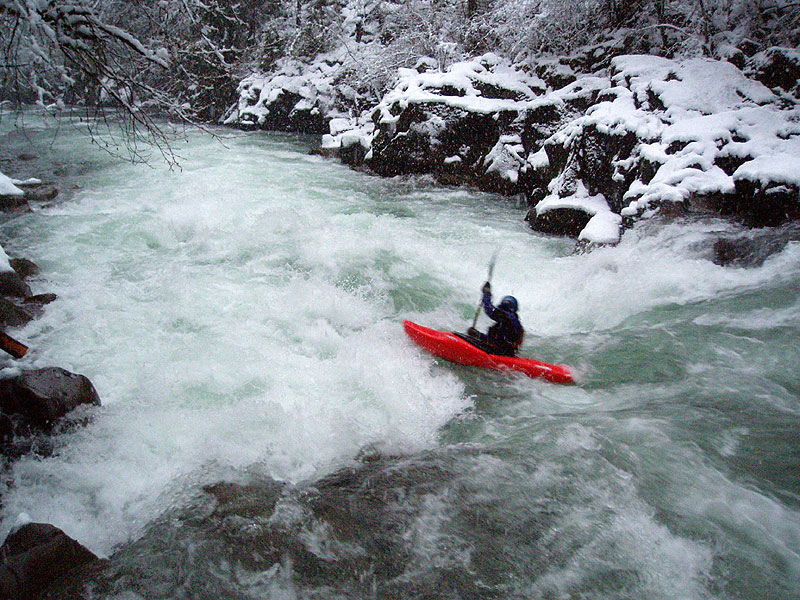 Ryan Scott clears the bottom hole.
Ryan Scott clears the bottom hole.
I really like this shot because you can see some of the huge silver-dollar sized snowflakes that were coming down this day.
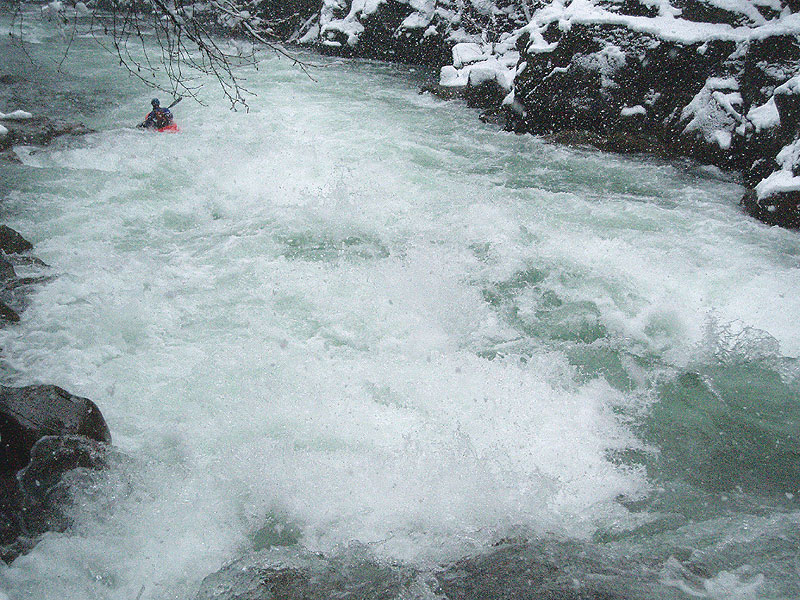 Waiting in the eddy below Rams Horn on a recent winter run.
Waiting in the eddy below Rams Horn on a recent winter run.
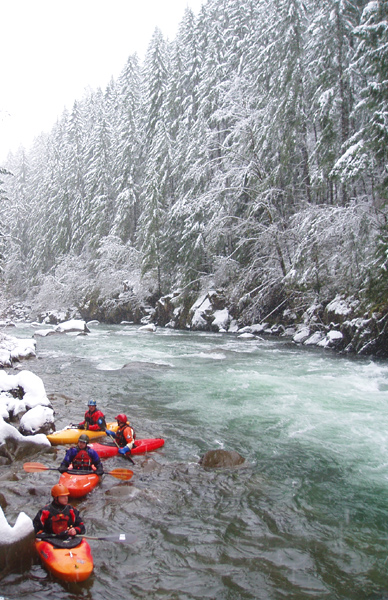 Below Rams Horn are several fun drops, including Balls to the Wall Right
and Balls to the Wall Left. BTW Right comes up first, and can be
identified by the short basalt wall on the right hand side. This steep,
semi-blind drop is
notable
for a sizeable
hole against the right wall which tends to knock unsuspecting boaters off
line..
Jon approaches the main hole in BTW Right..
Below Rams Horn are several fun drops, including Balls to the Wall Right
and Balls to the Wall Left. BTW Right comes up first, and can be
identified by the short basalt wall on the right hand side. This steep,
semi-blind drop is
notable
for a sizeable
hole against the right wall which tends to knock unsuspecting boaters off
line..
Jon approaches the main hole in BTW Right..
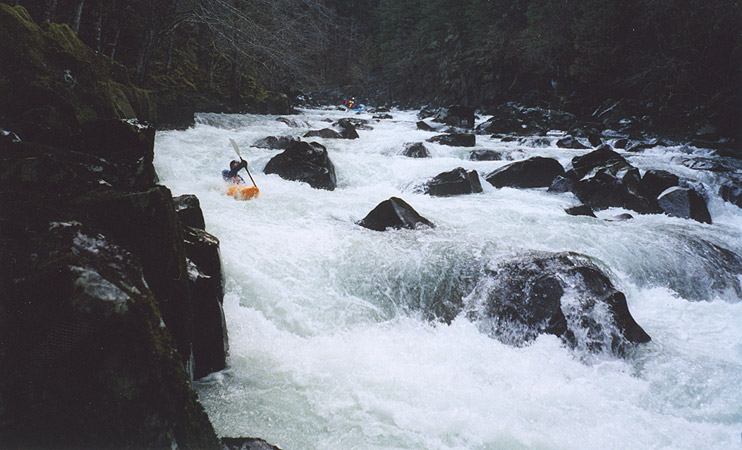 Below BTW Left are a few more nice drops leading up to Climax, a
river-wide boulder ledge that develops a fearsome hole at high water. The
usual line here is center-left, riding off a nice boof flake, or right, or left depending on the flows.
Katie Wagner and Jason Schroeder wait for the rest of the group below Climax while the snow comes down.
Below BTW Left are a few more nice drops leading up to Climax, a
river-wide boulder ledge that develops a fearsome hole at high water. The
usual line here is center-left, riding off a nice boof flake, or right, or left depending on the flows.
Katie Wagner and Jason Schroeder wait for the rest of the group below Climax while the snow comes down.
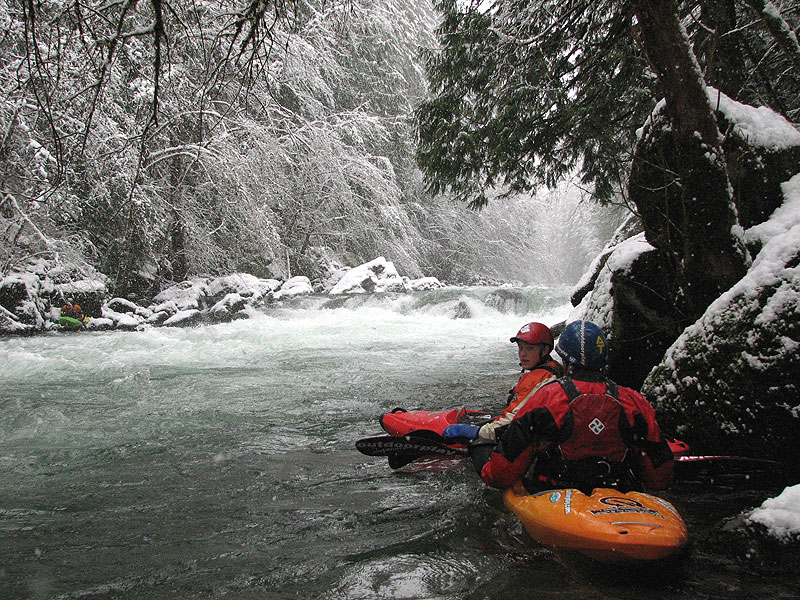 Keel Brightman emerges from the hole at Climax on a recent winter run.
Keel Brightman emerges from the hole at Climax on a recent winter run.
It was snowing very hard on this particular day, which was pretty cool!
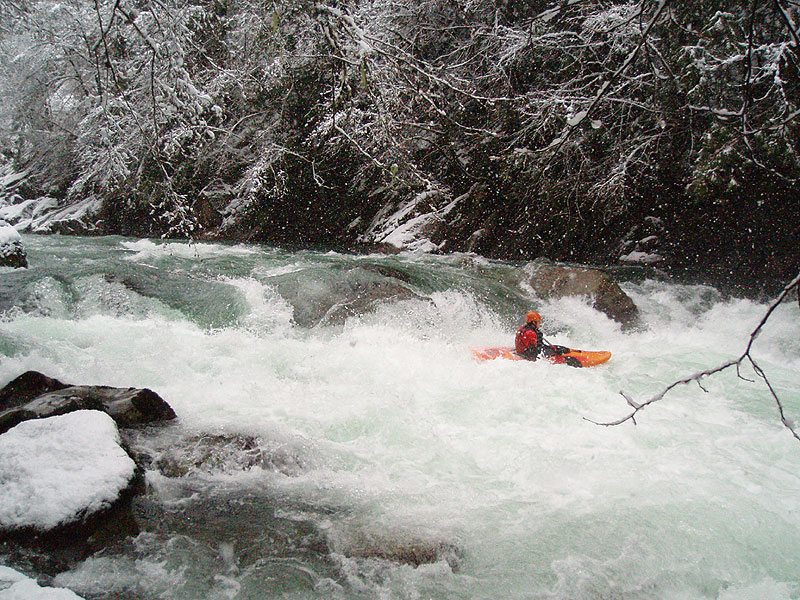 Below Climax there are a series of interesting and playful rapids (stay
far right for the best of it) for a mile or so, then the river mellows
considerably and you have a mellow three mile float to the take out.
FLOWS and BETA: The Wind is
primarily a rain-fed run. This section becomes serious
class five at high water; only experts familiar with the river should
attempt the Upper at high flows. A very good kayaker flush-drowned on this section
in the nineties during a high-water run, so be careful up there when the
rains fall hard.
Below Climax there are a series of interesting and playful rapids (stay
far right for the best of it) for a mile or so, then the river mellows
considerably and you have a mellow three mile float to the take out.
FLOWS and BETA: The Wind is
primarily a rain-fed run. This section becomes serious
class five at high water; only experts familiar with the river should
attempt the Upper at high flows. A very good kayaker flush-drowned on this section
in the nineties during a high-water run, so be careful up there when the
rains fall hard.
We use a rock in the middle of the river at the take-out as a gauge. The
rock has two 'horns' on it, and if the water is surging up between the
horns, that is an adequate medium-ish flow. If the rock is slightly
covered, expect some big water. If there are no rocks visible, only waves,
the river is class five and you'd better be on your game if you decide to
put on.
GAUGE ROCK PICS: Here's some
photos of the flow gauge-rock at the take-out
for the Upper Wind taken at
different
flows (the seasons are also different, so don't be thrown off
by that.
Both photos are taken from the same spot!)
MEDIUM-LOW FLOW:
In the photo below the river is medium-low and the gauge rock has both
horns
visible, and water is 'sloshing' up between the horns. This is an ok flow
for the upper and lower, both runs are class IV, but Panther Creek won't
be
runnable.
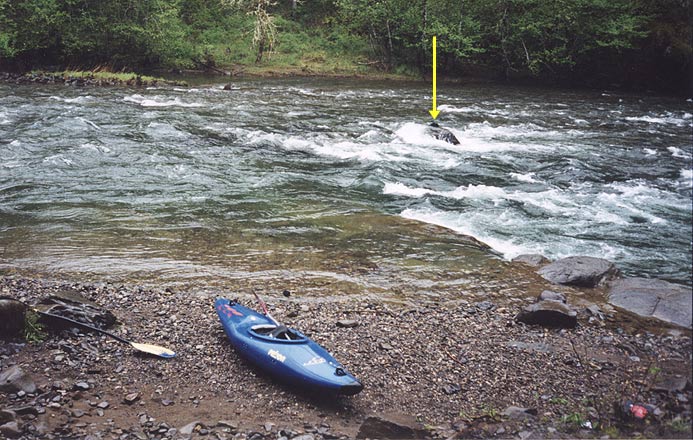
MEDIUM ( OPTIMAL ) FLOW:
In this photo there are a couple of inches covering the top of the gauge rock.
Panther Creek was at 18 inches ( a couple inches too low to run ), but this is an ideal medium flow for the Upper Wind, very fun!
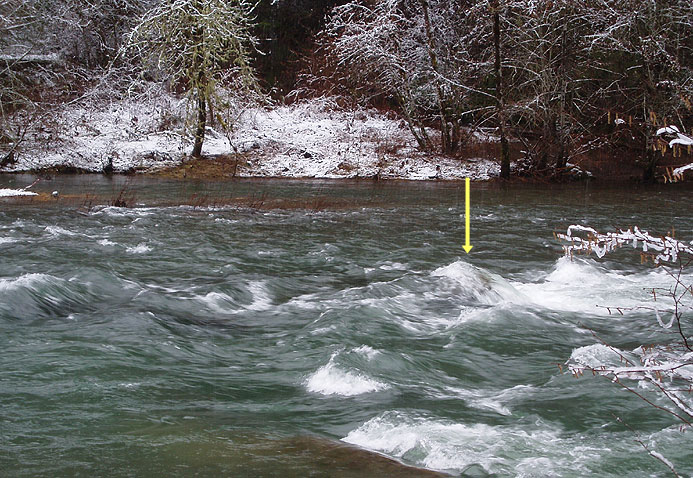
MEDIUM HIGH:
This photo below was taken just after we ran Panther Creek. The gauge rock is covered, and it is forming a wave-hole.
At this flow the upper and lower
are on the harder end of class IV or easy class V.
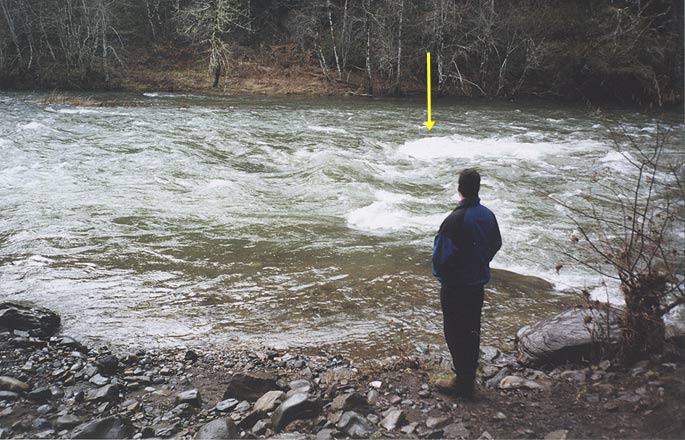
HIGH:
I don't have any photos taken when the river was running higher, but
suffice it to say when you arrive at the take-out and there are a series
of large waves where the gauge rock usually is, expect a big water class
five run.












